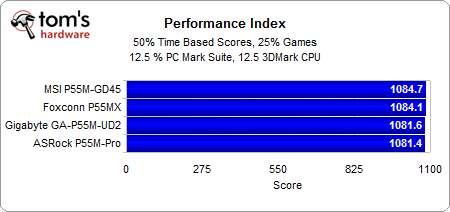Compact P55: Four MicroATX Motherboards Tried And Tested
Conclusion
As you can see in our performance index, none of the candidates are capable of gaining ground on the performance side. You can tweak memory timings or increase clock speeds, but the delivered performance results under identical conditions are pretty similar. This is a trend you'll likely see continue as more functionality is integrated into the processor itself, taking impetus away from the motherboard folks when it comes to establishing a compelling performance story.
We did some overclocking tests, as well. Since none of these boards were designed to be true overclockers, we limited our testing to seeing whether our Core i5-750 processor could be operated at 4.0 GHz with limited voltage modifications (+0.15 V max). This is probably the most reasonable maximum overclock.
All boards that support overclocking (ASRock, Gigabyte, and MSI) support our target clock speed properly and stably. It's a mystery to us why Foxconn thoroughly wiped out all overclocking support with its offering. Obviously, the LGA 1156-based platform, on a whole, has lots of headroom to allow for safe overclocking. Gigabyte and MSI provide best overclocking, and they both support ATI CrossFire and Nvidia’s SLI multi-card rendering technologies, though the use of one 16-lane PCIe 2.0 slot and one four-lane slot running at PCIe 1.1 transfer rates results in an ugly performance penalty in games. ASRock doesn’t support the two features, and Foxconn can’t due to limited PCIe slot availability.
Our efficiency comparison is won, narrowly, by MSI, which does the best job implementing dynamically switching voltage regulators. We enabled all possible power saving mechanisms from each vendor, but we refused to install software tools, as we believe these features have to work out of the box, and few enthusiasts are willing to install additional software to enable these extras. Foxconn takes the second spot, as its board has the fewest number of extra features and components, which in the end delivers a power advantage. ASRock and Gigabyte take the last spots, though they still facilitate decent results.
Finally, we also have to talk about features. ASRock provides two USB-powered eSATA slots, which you may want for eSATA thumb drives. All vendors except Foxconn have at least one eSATA port, along with UltraATA/133. Only ASRock and Gigabyte offer digital audio outputs. Foxconn and Gigabyte feature two classic PCI slots. A clear feature winner is hard to determine, but the Foxconn board only makes sense if you need go for an entry-level budget. Gigabyte is the most versatile, and MSI the most efficient. We found ASRock to be somewhere in the middle.
Get Tom's Hardware's best news and in-depth reviews, straight to your inbox.
